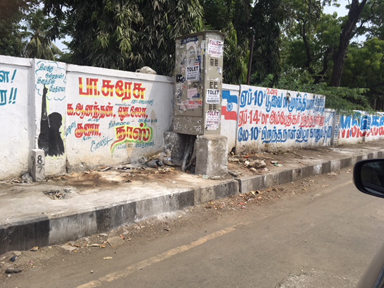Registered with the Registrar of Newspapers for India under R.N.I 53640/91
Vol. XXVIII No. 7, July 16-31, 2018
The hurdles City’s pedestrians face
by A Special Correspondent

“T’ Nagar Residents want their pavements back,” screams the headline in a newspaper that has taken up cudgels for the long-forgotten Pedestrian. A cynic asking, out of frustration, “When did they ever have it?”, is to be excused.
A search for statistics does not yield any meaningful data on the proportion of walkers on Chennai streets compared to vehicle users. It is a safe guess that Chennai must be among the most “walked on” cities in the country or even the world, till someone can disprove it. It is not just the numerical ratio being high, compared to other categories of road users, but the high density of walkers per unit of available road area. In more spacious cities, even if the walker ratio is high, the space available is large reducing the walkers’ hardship and risk. In cities of the developed world, known for their concern for pedestrians, there are protective and right-asserting devices to give the walking public a pleasant experience.

According to one study, an intelligent guess is that 30 per cent of total trips on roads are by foot indicating, happily, a preference for walking as a means of mobility. This needs to be recognised and even encouraged by making conducive provisions for walkers, modifying the vehicle-centric design of roads. Pedestrians cannot be told that they are using roads at their own risk. They must be facilitated to walk safely before they are told to be cautious of the risks on the road.
In Chennai, there are pavements but mostly as an apology for a facility. They are crude and risky for use, showing utter lack of concern for pedestrian needs. Space left-overs seem to have been thrown at pedestrians. Take it or leave it. (The words pavement, sidewalk, platform and walking path are used interchangeably to indicate the space reserved for walkers).
There are three parts to pedestrian needs – one, availability of easily accessible protected space for walking; two, provisions for risk-free, timely crossings; three, enforcement of action against irresponsible use of roads/pavements and reckless disregard of rules by motorised vehicles.

First, the design and specification of pavements. According to architectural standards observed in other countries a minimum two-person path should be 5 feet. Less is not of practical use. People shun away from narrow spaces. The height of raised pavements/side-walks should be in the range of 4 to 8 inches range as anything higher would become difficult to climb. In Western countries they are sometimes at the same level as the road but protected by a suggestively raised marker along the path for vehicles to keep away from pedestrian space. That will not work here as vehicles audaciously drive over highly raised platforms “to get there first”. In our situation, nothing short of insurmountable physical obstruction is needed!
Platforms are often built over drains and covered with rectangular slabs stacked unevenly with hard protrusions. There may even be a broken or missing slab with a gaping hole. These platforms are dangerous and not usable at all. (Photo 1). They are hardly 3 feet wide – too narrow and permitting only a single file. On a very broad road like Anna Salai, such a mingy space allowed for walkers is not at all understandable. (Photo 2) Cluttered sidewalks owing to unauthorised use is an open violation of the pedestrian’s right to safe passage. (Photo 3). Many platforms are so high that it requires much effort in climbing up and down.
The second need concerns crossing facilities. Foot overbridges are too high with many steps to climb. Walkers unwilling or unable to take the climb are forced to cross the roads disregarding speeding traffic and taking high risks. When speeding vehicles intimidate and prevent pedestrians from using the zebra crossing, there is little to protect them.
The third factor is enforcement. Irresponsible driving, going unchecked, is a grave risk that pedestrians are exposed to every day. Not stopping for pedestrians and speeding at intersections, quite often defying the red signal, places pedestrians and others at grave risk. The high number of pedestrian deaths, experts say, is because footpaths are encroached by shops, food carts, parked vehicles and political banners. Unauthorised persons are reported to be collecting rentals of Rs. 1,500 per day per user for permitting use of public space meant for pedestrian safety. Over time, illegal squatters’ “rights” have solidified and already become difficult to solve without losing votes. This problem must be faced squarely and resolved to retrieve public space meant for pedestrian safety.
Sidewalk designing is a speciality architecture and calls for sensitivity and imagination in design. The City sidewalks have been left to masons to pile up rubble and cover it with concrete slabs. It is time that it is left to town planning architectural specialists to design side-walks that make walking safe and the City beautiful. It is reported that the Government has decided to empower the Smart City Limited, a special vehicle to implement the Smart City Project, to sanction component projects up to Rs. 25 crore. Advantage must be taken of this relaxation to modernise the City pavements without delay. Walkers, by and large, represent the poor and the middle class and are much larger in number than illegal occupants. Their needs must be met and their hearts won before the next election.

